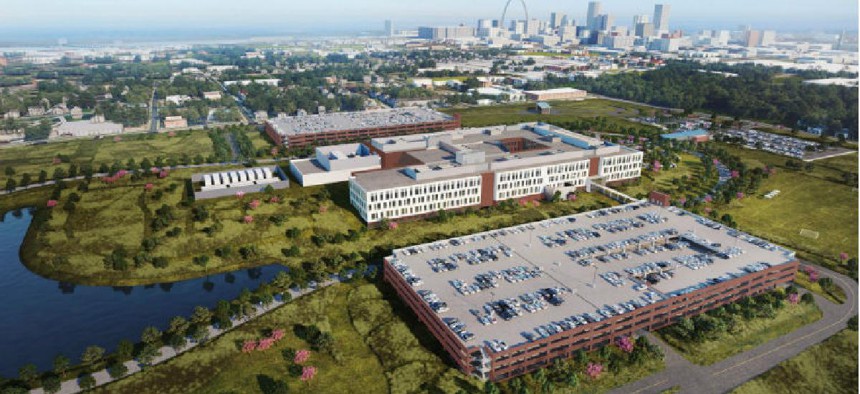How NGA is tackling interoperability challenges

Mark Munsell, the National Geospatial-Intelligence Agency’s CTO, talks about talent shortages and how the agency is working to get more unclassified data.

Aerial rendering of designs for the Next NGA West campus in St. Louis (Image credit: James Lowe/U.S. Army Corps of Engineers)
The National Geospatial-Intelligence Agency is all about data. And the agency, which is set to break ground on a new nearly $2 billion facility in St. Louis later this month, is hoping to get more of it unclassified for better analysis and information for the warfighter.
FCW talked with Mark Munsell, NGA's CTO about some of the barriers to declassifying images and what that translates to for the digital workforce.
How is NGA working to declassify images to get a more robust dataset to further the intelligence mission?
Taking advantage of all the new commercial businesses out there today that are either launching satellites and collecting unclassified information or taking advantage of open source information that has a geospatial tag of space and time associated with it so we can aggregate that information with it and then correlate it with other information other intelligence information that we have. So it's about commercial entities that are out there in the business of providing that either for commercial purposes or to sell to the Defense Department.
What challenges are NGA facing when it comes to aggregating data, simplifying it and making sure it's usable for analysis?
Most of our analysts work in a classified environment, and so the problem is where do we converge that information. Do we take all of this information and bring it to a classified environment, which is costly and duplicative? Or do we try to have them interact with the information at an unclassified level, which is a technical difficulty?
It also sounds like there's a policy aspect to that too regarding classification levels. Are there any difficulties in that respect?
Yes, based on the simple fact that -- We're not talking about personal information or anything like that. We're talking about companies like Planet, companies like Maxar, which have been in the business of commercial remote sensing data for many, many years. So the policy is mostly about getting the security policy right to interact between classified and unclassified environments.
That sounds a little similar to some of the interoperability challenges the Army has been working on; trying to flow information between classification levels in tactical environments.
Very difficult to do, very protective, don't want to leave the door open.
Pivoting back to NGA, what pilots and prototypes is your office working on?
In my office in particular, because NGA is a digital enterprise -- I mean we're 100% information analytics -- we're trying to hire more digital practitioners inside the government.
Are you having any trouble with that? The Defense Innovation Board came out with digital workforce hiring recommendations that included using faster, alternative mechanisms to bring people on board. What are you seeing?
We're looking at incentives. Ultimately at the end of the day, it's the right kind of people; the people that want to work in the Defense Department. It's the people that have some sense of belonging to something bigger than themselves that wins the day. Compensation is important, but what we find are the people who like to work for us are the people that have some sort of connection to a bigger purpose. They will work for a government salary if they feel like they're contributing to society and United States national security.
Are the current mechanisms in place, the current authorities, are they adequate or is NGA looking for something different on the hiring side?
I think the entire government struggles with this. And we're happy to have incentives put in place -- either extra pay or a different pay scale -- or really get the policy down in the government that we can set up an environment where they work as a digital practitioner or data scientist or software developer.
Does NGA have a career track for data scientists?
Yes, yes. And a resurgence of a software engineering occupation. So both data science occupation and software engineering occupations, we've had a resurgence of those in the last several years inside NGA and a concerted effort to build those occupations. And so compensation is one thing but the other big thing is the right environment. We have built our environments in these organizations to be so secure that you can't build to make things. It was designed so that you can't do that because if you could build or make something, that's a security problem. So we've had to flip that on its head and say, how can we provide an environment that's still secure but also lets builders and makers create things.
It almost sounds like what the Army has tried to do with Futures Command and putting everyone in the same space in Austin to help foster idea-generation and break things and put them back together.
Yeah, it's the same kind of concept. We're trying to do it from within. So we're building a brand new facility in St. Louis, and we're designing that facility with these things in mind — like an unclassified environment, a software development environment — we're designing the facility to do the things both from an aesthetic, architecture point of view and a security point of view.
This interview has been edited for length and clarity.






